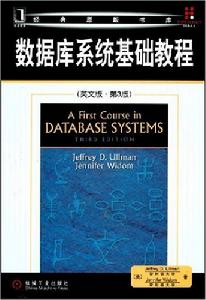內容簡介
 《資料庫系統基礎教程(英文版)》
《資料庫系統基礎教程(英文版)》本書由美國史丹福大學知名計算機科學家JeffreyUllman和JenniferWidom合作編寫。書中介紹了核心DBMS概念、理論和模型,描述了如何使用抽象語言和SQL查詢與更新DBMS。在介紹了SQL擴展內容(包括嵌入式SQL程式設計和對象關係特徵)後,又介紹了使用XML的系統。設計語言包括XML模式,查詢語言包括XPath和XQuery。
本書特色
全面改版的組織結構。
UML資料庫模型的新內容。
包括3NF綜合算法在內的操作依賴新算法的引入。
更多的3NF,包括3NF綜合算法。
擴展的SQL觸發討論。
新增的索引選擇和物化視圖。
新增的三層體系結構。
新增的PHP。
新增的OLAP和SQL立方體操作符介紹。
擴展的XML內容,包括XML模式、XPath、XQuery和XSLT。
作者簡介
作者:JeffreyD.Ullman
JeffreyD.Ullman史丹福大學計算機科學系StanfordW.Ascherman教授,資料庫技術專家。他獨立或與人合作出版了15本著作,發表了170多篇技術論文。他的研究興趣包括資料庫理論、資料庫集成、數據挖掘和利用信息基礎設施進行教育。他是美國國家工程院成員,曾獲得Knuth獎、SIGMOD貢獻獎、Karlstrom傑出教育家獎和EdgarF.Codd發明獎。
目錄
TheWorldsofDatabaseSystems
1.1TheEvolutionofDatabaseSystems
1.1.1EarlyDatabaseManagementSystems
1.1.2RelationalDatabaseSystems
1.1.3SmallerandSmallerSystems
1.1.4BiggerandBiggerSystems
1.1.5InformationIntegration
1.2OverviewofaDatabaseManagementSystem
1.2.1Data-DefinitionLanguageCommands
1.2.2OverviewofQueryProcessing
1.2.3StorageandBufferManagement
1.2.4TransactionProcessing
1.2.5TheQueryProcessor
1.3OutlineofDatabase-SystemStudies
1.4ReferencesforChapter1
IRelationalDatabaseModeling
2TheRelationalModelofData
2.1AnOverviewofDataModels
2.1.1WhatisaDataModel?
2.1.2ImportantDataModels
2.1.3TheRelationalModelinBrief
2.1.4TheSemistructuredModelinBrief
2.1.5OtherDataModels
2.1.6ComparisonofModelingApproaches
2.2BasicsoftheRelationalModel
2.2.1Attributes
2.2.2Schemas
2.2.3Tuples
2.2.4Domains
2.2.5EquivalentRepresentationsofaRelation
2.2.6RelationInstances
2.2.7KeysofRelations
2.2.8AnExampleDatabaseSchema
2.2.9ExercisesforSection2.2
2.3DefiningaRelationSchemainSQL
2.3.1RelationsinSQL
2.3.2DataTypes
2.3.3SimpleTableDeclarations
2.3.4ModifyingRelationSchemas
2.3.5DefaultValues
2.3.6DeclaringKeys
2.3.7ExercisesforSection2.3
2.4AnAlgebraicQueryLanguage
2.4.1WhyDoWeNeedaSpecialQueryLanguage?
2.4.2WhatisanAlgebra?
2.4.3OverviewofRelationalAlgebra
2.4.4SetOperationsonRelations
2.4.5Projection
2.4.6Selection
2.4.7CartesianProduct
2.4.8NaturalJoins
2.4.9Theta-Joins
2.4.10CombiningOperationstoFormQueries
2.4.11NamingandRenaming
2.4.12RelationshipsAmongOperations
2.4.13ALinearNotationforAlgebraicExpressions
2.4.14ExercisesforSection2.4
2.5ConstraintsonRelations
2.5.1RelationalAlgebraasaConstraintLanguage
2.5.2ReferentialIntegrityConstraints
2.5.3KeyConstraints
2.5.4AdditionalConstraintExamples
2.5.5ExercisesforSection2.5
2.6SummaryofChapter2
2.7ReferencesforChapter2
DesignTheoryforRelationalDatabases
3.1FunctionalDependencies
3.1.1DefinitionofFunctionalDependency
3.1.2KeysofRelations
3.1.3Superkeys
3.1.4ExercisesforSection3.1
3.2RulesAboutFunctionalDependencies
3.2.1ReasoningAboutFunctionalDependencies
3.2.2TheSplitting/CombiningRule
3.2.3nivialFunctionalDependencies
3.2.4ComputingtheClosureofAttributes
3.2.5WhytheClosureAlgorithmWorks
3.2.6TheTransitiveRule
3.2.7ClosingSetsofFunctionalDependencies
3.2.8ProjectingFunctionalDependencies
3.2.9ExercisesforSection3.2
3.3DesignofRelationalDatabaseSchema
3.3.1Anomalies
3.3.2DecomposingRelations
3.3.3Boyce-CoddNormalForm
3.3.4DecompositionintoBCNF
3.3.5ExercisesforSection3.3
3.4Decomposition:TheGood,Bad,andUgly
3.4.1RecoveringInformationfromaDecomposition
3.4.2TheChaseTestforLosslessJoin
3.4.3WhytheChaseworks
3.4.4DependencyPreservation
3.4.5ExercisesforSection3.4
3.5ThirdNormalForm
3.5.1DefinitionofThirdNormalForm
3.5.2TheSynthesisAlgorithmfor3NFSchemas
3.5.3Whythe3NFSynthesisAlgorithmWorks
3.5.4ExercisesforSection3.5
3.6MultivaluedDependencies
3.6.1AttributeIndependenceandItsConsequentRedundancy
3.6.2DefinitionofMultivaluedDependencies
3.6.3ReasoningAboutMultivaluedDependencies
3.6.4F0urthNormalForm
3.6.5DecompositionintoFourthNormalForm
3.6.6RelationshipsAmongNormalForms
3.6.7ExercisesforSection3.6
3.7AnAlgorithmforDiscoveringMVD'S
3.7.1TheClosureandtheChase
3.7.2ExtendingtheChasetoMVD's
3.7.3WhytheChaseW10rksforMVD'S
3.7.4ProjectingMVD'S
3.7.5ExercisesforSection3.7
3.8SummaryofChapter3
3.9ReferencesforChapter3
4High-LevelDatabaseM0dels
5AlgebraicandLogicalQueryLanguages
6TheDatabaseLanguageSQL
7ConstraintsandTriggers
8ViewsandIndexes
9SQLinaServerEnvironment
10AdvancedTopicsinRelationalDatabases
ⅢModelingandProgrammingforsemistructuredData
……

